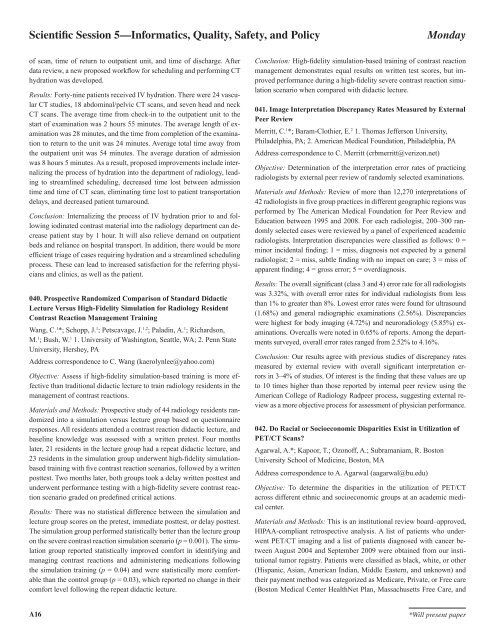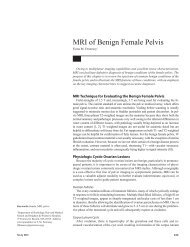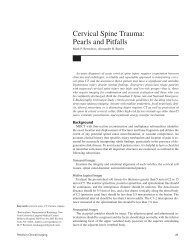Scientific Session 1 â Breast Imaging: Mammography
Scientific Session 1 â Breast Imaging: Mammography
Scientific Session 1 â Breast Imaging: Mammography
Create successful ePaper yourself
Turn your PDF publications into a flip-book with our unique Google optimized e-Paper software.
<strong>Scientific</strong> <strong>Session</strong> 5—Informatics, Quality, Safety, and PolicyMondayof scan, time of return to outpatient unit, and time of discharge. Afterdata review, a new proposed workflow for scheduling and performing CThydration was developed.Results: Forty-nine patients received IV hydration. There were 24 vascularCT studies, 18 abdominal/pelvic CT scans, and seven head and neckCT scans. The average time from check-in to the outpatient unit to thestart of examination was 2 hours 55 minutes. The average length of examinationwas 28 minutes, and the time from completion of the examinationto return to the unit was 24 minutes. Average total time away fromthe outpatient unit was 54 minutes. The average duration of admissionwas 8 hours 5 minutes. As a result, proposed improvements include internalizingthe process of hydration into the department of radiology, leadingto streamlined scheduling, decreased time lost between admissiontime and time of CT scan, eliminating time lost to patient transportationdelays, and decreased patient turnaround.Conclusion: Internalizing the process of IV hydration prior to and followingiodinated contrast material into the radiology department can decreasepatient stay by 1 hour. It will also relieve demand on outpatientbeds and reliance on hospital transport. In addition, there would be moreefficient triage of cases requiring hydration and a streamlined schedulingprocess. These can lead to increased satisfaction for the referring physiciansand clinics, as well as the patient.040. Prospective Randomized Comparison of Standard DidacticLecture Versus High-Fidelity Simulation for Radiology ResidentContrast Reaction Management TrainingWang, C. 1 *; Schopp, J. 1 ; Petscavage, J. 1,2 ; Paladin, A. 1 ; Richardson,M. 1 ; Bush, W. 1 1. University of Washington, Seattle, WA; 2. Penn StateUniversity, Hershey, PAAddress correspondence to C. Wang (kaerolynlee@yahoo.com)Objective: Assess if high-fidelity simulation-based training is more effectivethan traditional didactic lecture to train radiology residents in themanagement of contrast reactions.Materials and Methods: Prospective study of 44 radiology residents randomizedinto a simulation versus lecture group based on questionnaireresponses. All residents attended a contrast reaction didactic lecture, andbaseline knowledge was assessed with a written pretest. Four monthslater, 21 residents in the lecture group had a repeat didactic lecture, and23 residents in the simulation group underwent high-fidelity simulationbasedtraining with five contrast reaction scenarios, followed by a writtenposttest. Two months later, both groups took a delay written posttest andunderwent performance testing with a high-fidelity severe contrast reactionscenario graded on predefined critical actions.Results: There was no statistical difference between the simulation andlecture group scores on the pretest, immediate posttest, or delay posttest.The simulation group performed statistically better than the lecture groupon the severe contrast reaction simulation scenario (p = 0.001). The simulationgroup reported statistically improved comfort in identifying andmanaging contrast reactions and administering medications followingthe simulation training (p = 0.04) and were statistically more comfortablethan the control group (p = 0.03), which reported no change in theircomfort level following the repeat didactic lecture.Conclusion: High-fidelity simulation-based training of contrast reactionmanagement demonstrates equal results on written test scores, but improvedperformance during a high-fidelity severe contrast reaction simulationscenario when compared with didactic lecture.041. Image Interpretation Discrepancy Rates Measured by ExternalPeer ReviewMerritt, C. 1 *; Baram-Clothier, E. 2 1. Thomas Jefferson University,Philadelphia, PA; 2. American Medical Foundation, Philadelphia, PAAddress correspondence to C. Merritt (crbmerritt@verizon.net)Objective: Determination of the interpretation error rates of practicingradiologists by external peer review of randomly selected examinations.Materials and Methods: Review of more than 12,270 interpretations of42 radiologists in five group practices in different geographic regions wasperformed by The American Medical Foundation for Peer Review andEducation between 1995 and 2008. For each radiologist, 200–300 randomlyselected cases were reviewed by a panel of experienced academicradiologists. Interpretation discrepancies were classified as follows: 0 =minor incidental finding; 1 = miss, diagnosis not expected by a generalradiologist; 2 = miss, subtle finding with no impact on care; 3 = miss ofapparent finding; 4 = gross error; 5 = overdiagnosis.Results: The overall significant (class 3 and 4) error rate for all radiologistswas 3.32%, with overall error rates for individual radiologists from lessthan 1% to greater than 8%. Lowest error rates were found for ultrasound(1.68%) and general radiographic examinations (2.56%). Discrepancieswere highest for body imaging (4.72%) and neuroradiology (5.85%) examinations.Overcalls were noted in 0.65% of reports. Among the departmentssurveyed, overall error rates ranged from 2.52% to 4.16%.Conclusion: Our results agree with previous studies of discrepancy ratesmeasured by external review with overall significant interpretation errorsin 3–4% of studies. Of interest is the finding that these values are upto 10 times higher than those reported by internal peer review using theAmerican College of Radiology Radpeer process, suggesting external reviewas a more objective process for assessment of physician performance.042. Do Racial or Socioeconomic Disparities Exist in Utilization ofPET/CT Scans?Agarwal, A.*; Kapoor, T.; Ozonoff, A.; Subramaniam, R. BostonUniversity School of Medicine, Boston, MAAddress correspondence to A. Agarwal (aagarwal@bu.edu)Objective: To determine the disparities in the utilization of PET/CTacross different ethnic and socioeconomic groups at an academic medicalcenter.Materials and Methods: This is an institutional review board–approved,HIPAA-compliant retrospective analysis. A list of patients who underwentPET/CT imaging and a list of patients diagnosed with cancer betweenAugust 2004 and September 2009 were obtained from our institutionaltumor registry. Patients were classified as black, white, or other(Hispanic, Asian, American Indian, Middle Eastern, and unknown) andtheir payment method was categorized as Medicare, Private, or Free care(Boston Medical Center HealthNet Plan, Massachusetts Free Care, andA16*Will present paper
















